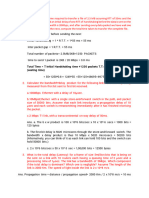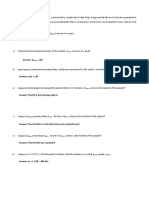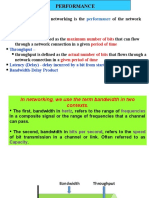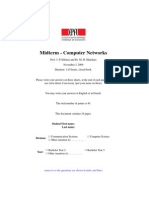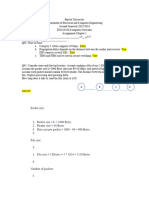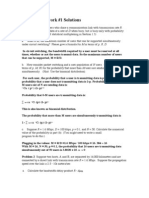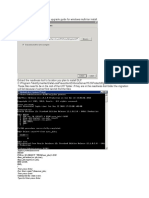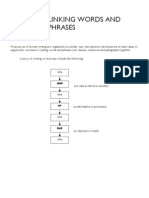Example Problems
Example Problems
Uploaded by
atiffitaCopyright:
Available Formats
Example Problems
Example Problems
Uploaded by
atiffitaOriginal Description:
Copyright
Available Formats
Share this document
Did you find this document useful?
Is this content inappropriate?
Copyright:
Available Formats
Example Problems
Example Problems
Uploaded by
atiffitaCopyright:
Available Formats
CS176A Example Problems
Calculate the total time required to transfer a 1.5 MB file in the following cases, assuming RTT
of 80ms, a packet size of 1KB and an initial 2XRTT of handshaking before it is sent.
a) The b/w is 10Mbps, and the data packets can be sent continuously.
b) The b/w is 10Mbps, but after we finish sending each data packet, we must wait one RTT
before sending the next
c) The link allows infinitely fast transmits, but limits bandwidth such that only 20 packets can be
sent per RTT zero transmit time as in (c), but during the first RTT, we can send one packet
during the 2
nd
RTT we can send 2 packets, during the 3rs we can send 4 = 2
3
-1 and so on
Solution:
We will count the transfer as completed when the last data bit arrives at its destination
a) 1.5MB =12,582,912 bits, 2 initial RTTs (160ms) +(12,582,912)/(10,000,000) bps (transmit) +
RTT/2 (propagation) =1.458 secs (approx)
b) To the above, we add the time for 1499 RTTs for a total of 1.46 +119.92 =121.38 secs
c) This is 74.5 RTTs, plus the two initial RTTS, for 6.12 secs
d) Right after the handshaking is done, we send one packet. One RTT after handshaking, we send 2
packets. At n RTTs past the handshaking, we have sent 1+2+4+... +2
n
=2
(n+1)
1. At n =10, we have
thus been able to send all 1500 pkts, the last batch arrives 0.5 RTT later. Total time is 2 +10.5 RTTs or
1 sec.
Suppose a 128 kbps p2p link is set up between earth and a rover on mars. The distance from the
earth to mars (when they are the closest together) is approximately 55Gm, and data travels over
the link at the speed of light 3X10
8
m/s
a) Calculate the minimum RTT for the link
b) Calculate the delay X bandwidth product of the link
c) A camera on the rover takes pictures of its surroundings and sends these to the earth. How
quickly can it reach Mission Control on Earth? Assume that each image is 5Mb in size
Solution:
a) Propagation Delay of the link is 55X10
9
/ (3X10
8
) =184 secs, Thus RTT =368 secs
b) The delay X bandwidth product for the link is the RTT X bandwidth =23.5Mb
c) After a picture is taken, it must be transmitted on the link and completely propagated, before Mission
Control can interpret it. Transmit delay for 5Mb of data is 29 secs
Hence, total time =transmit delay +propagation delay=223 secs
Calculate the latency (from first bit sent to the lat bit received) for the following:
a) 1 Gbps Ethernet with a single store and forward switch in the path, and a packet size of
5000bits. Assume that each link introduces a propagation delay of 10 micro second and
that the switch begins retransmitting immediately after it has finished receiving the
packet.
b) Same as a) but with 3 switches
c) Same as b) but assume the switch implements cut-through switching. It is also able to
begin retransmitting the packet after the first 128 bits have been received.
Solution:
a) For each link it takes 1 Gbps/5 Kb =5 s to transmit the packet on the link, after which it takes an
additional 10 s for the last bit to propagate across the link. Thus for a LAN with only with only one
switch that starts forwarding only after receiving the whole packet, the total transfer delay is the
transmit delays +two propagate delays =30 s.
b) For 3 switched and thus 4 links, the total delay is 4 transmit +4 prop. Delay =60 s
c) For cut-through , a switch needs to only decode the 128 bits before it begins to forward. This
takes 128 ns. This delay replaces the switch transmit delays in the previous answer for a total delay of
one transmit delay +3 cut through decoding delays +4 propagation delays =45.384 s
For the following, assume that no data compression is done. Calculate the bandwidth necessary
for transmitting in real time.
a) HDTV high-resolution video at resolution of 1920*1080, 24 bits/pixel, 30 frames / second.
b) POTS (Plain Old Telephone Service) voice audio of 8-bits samples at 8 KHz
c) GSM mobile voice audio of 260-bit samples at 50 Hz.
d) HDCD high-definition audio of 24-bit samples at 88.2 KHz
a) 1920 * 1080 * 24 * 30 ~=115 Gbps
b) 8 * 8000 =61 Kbps
c) 260 * 50 =13 Kbps
d) 24 * 882000 ~=2.1Mbps
Consider an application that transmits data at a steady rate (for example, the sender generates
an N-bit unit of data every k time units, where k is small and fixed). Also, when such an
application starts, it will continue running for relatively longer period of time. Answer the
following questions briefly justifying your answer:
a) Would a packet switched network or a circuit switched network more appropriate for this
application? Why?
b) Suppose that a packet switched network is used and the only traffic in this network comes
from such applications described above. Further assume that the sum of the application data
rates is less than the capacities of each and every link. Is some form of congestion control
needed? Why?
a) A circuit-switched network would be well suited to the application described, because
the application involves long sessions with predictable smooth bandwidth requirements.
Since the transmission rate is known and not bursty, bandwidth can be reserved for each
application session circuit with no significant waste. In addition, we need not worry
greatly about the overhead costs of setting up and tearing down a circuit connection,
which are amortized over the lengthy duration of a typical application session.
b) Given such generous link capacities, the network needs no congestion control mechanism. In the
worst (most potentially congested) case, all the applicationssimultaneously transmit over one or more
particular network links. However, since eachlink offers sufficient bandwidth to handle the sum of all
of the applications' data rates, nocongestion (very little queuing) will occur.
In modern packet switched networks, the source host segments long application layer messages
(for example an image or a music file) into smaller packets and sends the packets into the
network. The receiver then reassembles the packets back into the original message. We refer to
this process as message segmentation. Fig illustrates the end to end transport of a message with
and without segmentation. Consider a msg that is 7.5*10
6
bits long that is to be sent from the
source to the destination as shown in the figure. Suppose that each link in the figure is 1.5 Mbps.
Ignore propagation, queuing and processing delays.
a) consider sending the message from source to destination without message segmentation. How
long does it take to move the message from the source host to the first packet switch? Keeping in
mind that each packet switch uses a store and forward packet switching. What is the total time to
move the message from the source host to the destination host?
b) Now suppose that the message is segmented into 5,000 packets, with each packet being 1500
bits long. How long does it take to move the the first packet from the source host to the first
packet switch?
c) How long does it take to move the file from the source host to the destination host when
message segmentation is used? Compare with part A and comment.
d) Discuss the drawbacks of message segmentation.
a) Time to send message from source host to first packet switch =
7.5 10
6
sec =5 sec . With store-and-forward switching, the total time to move
1.5 10
6
message from source host to destination host =5 sec3 hops =15 sec
b) Time to send 1st packet from source host to first packet switch =1.5 10
3
sec =1 m sec. Time at
which 2nd packet is received at the first switch =1.5 10
6
time at which 1st packet is received at the
second switch =2 1 m sec =2 m sec
c) Time at which 1st packet is received at the destination host =1 m sec3 hops =3 m sec . After this,
every 1msec one packet will be received; thus time at which last (5000th) packet is received =3 m sec+
4999 * 1m sec =5.002 sec. It can be seen that delay in using messagesegmentation is significantly less
(almost 1/3rd).
d) Drawbacks:
i. packets have to be put in sequence at the destination.
ii. Message segmentation results in many smaller packets. Since header size is usually the
same for all packets regardless of their size, with message segmentation the total amount of header
bytes is more.
You might also like
- hw1 SolDocument11 pageshw1 Solvictrongkhang1100% (1)
- Bluecoat Proxy SG Dumps 250-430 Q&A-ExamAreaDocument24 pagesBluecoat Proxy SG Dumps 250-430 Q&A-ExamAreaatiffitaNo ratings yet
- CCN Examples Chapter 1 and 2Document6 pagesCCN Examples Chapter 1 and 2sundarNo ratings yet
- DLP 12.5 RFP Responses FinalDocument60 pagesDLP 12.5 RFP Responses Finalatiffita50% (2)
- Astm D3034-00 PDFDocument10 pagesAstm D3034-00 PDFericpardo59100% (4)
- Civil Foreman Interview QuestionDocument3 pagesCivil Foreman Interview QuestionSyed M. Imran Ali100% (5)
- Homework1 Solution PDFDocument7 pagesHomework1 Solution PDFTam HoangNo ratings yet
- Review TCPDocument26 pagesReview TCPAyyappaGolluNo ratings yet
- Simulation of Digital Communication Systems Using MatlabFrom EverandSimulation of Digital Communication Systems Using MatlabRating: 3.5 out of 5 stars3.5/5 (22)
- Regulation Medicaldevices PDFDocument71 pagesRegulation Medicaldevices PDFGina ArcNo ratings yet
- Schematic Design Quality Management Phase ChecklistDocument9 pagesSchematic Design Quality Management Phase ChecklistUzair Ghafoor MughalNo ratings yet
- Chads Creative Concepts Case StudyDocument5 pagesChads Creative Concepts Case StudyJoe Nathaniel100% (1)
- Solutions To Chapter 1 ProblemsDocument3 pagesSolutions To Chapter 1 ProblemsDr. SASIKALA DEVI. NNo ratings yet
- Problems: SolutionDocument2 pagesProblems: Solutionsushmita ratagalNo ratings yet
- Computer Networks HW1 SolutionsDocument18 pagesComputer Networks HW1 SolutionsKatie LoNo ratings yet
- Assignment 2Document6 pagesAssignment 2SyedMeesumHaiderNo ratings yet
- ACN AssignmentDocument2 pagesACN AssignmentmetallicamegadNo ratings yet
- hw01 SolnDocument2 pageshw01 SolnTam Duong TranNo ratings yet
- l201219@lhr - Nu.edu - PK M.irteza@nu - Edu.pk: (5 Marks)Document6 pagesl201219@lhr - Nu.edu - PK M.irteza@nu - Edu.pk: (5 Marks)jazib1921No ratings yet
- Home Assignment - 1 PDFDocument3 pagesHome Assignment - 1 PDFSatya GopalNo ratings yet
- DNP ProblemsDocument3 pagesDNP ProblemsAnilkumar SNo ratings yet
- CSCI5273 PS1 KiranJojareDocument8 pagesCSCI5273 PS1 KiranJojareSales TeamNo ratings yet
- Delay SolutionsDocument7 pagesDelay Solutionsstanley umohNo ratings yet
- WINSEM2019-20 CSE1004 ETH VL2019205001155 Reference Material I 16-Dec-2019 PROBLEMSDocument9 pagesWINSEM2019-20 CSE1004 ETH VL2019205001155 Reference Material I 16-Dec-2019 PROBLEMSADITYA SINGHNo ratings yet
- ECE358 Homework1 SolutionsDocument10 pagesECE358 Homework1 SolutionsRama Krishna MuttavarapuNo ratings yet
- ACN Examples 2024 - 1Document5 pagesACN Examples 2024 - 1tempmail6077No ratings yet
- Assignment 1 SolutionDocument6 pagesAssignment 1 Solutionjazib1921No ratings yet
- Algorithm in Computer NetworkDocument16 pagesAlgorithm in Computer NetworkLuttpiNo ratings yet
- Unit 1 Problem SolutionsDocument9 pagesUnit 1 Problem SolutionsSashank PNo ratings yet
- Bài giải computer networking a top down approachDocument12 pagesBài giải computer networking a top down approachAnh RiNo ratings yet
- Homework 1 EbookDocument5 pagesHomework 1 EbookEmma Safwanah SahirinNo ratings yet
- Solution To Practice Problem Set 1Document3 pagesSolution To Practice Problem Set 1agentrangomanNo ratings yet
- Co1 ProblemsDocument7 pagesCo1 ProblemsJayanthkumarNo ratings yet
- Chapter 1Document3 pagesChapter 1sajjad.ab2020No ratings yet
- Lab 4 Cisco Seidygali DarynDocument4 pagesLab 4 Cisco Seidygali DaryndarynNo ratings yet
- HW 4Document4 pagesHW 4Abdulla AlimNo ratings yet
- Assignment 1Document9 pagesAssignment 1RamaNo ratings yet
- Networks - Ch1 - HWDocument2 pagesNetworks - Ch1 - HWSeif HawamdehNo ratings yet
- Homework 1 SolutionDocument6 pagesHomework 1 SolutionAbdelhakim KhlifiNo ratings yet
- 1Document13 pages1Anoop JamadagniNo ratings yet
- Solutions To Assignment1Document4 pagesSolutions To Assignment1semacokNo ratings yet
- Networks HW 1Document4 pagesNetworks HW 1Ross HallNo ratings yet
- Module-2.1-Switching ProblemsDocument12 pagesModule-2.1-Switching ProblemsAchin BatwaraNo ratings yet
- 8-Network Performance-17!01!2022 (17-Jan-2022) Material I 17-01-2022 PerformanceDocument21 pages8-Network Performance-17!01!2022 (17-Jan-2022) Material I 17-01-2022 PerformancePrerna SinghNo ratings yet
- ECSE 414 - Intro To Telecom Networks - Fall 2007 Midterm 2007 SolutionsDocument6 pagesECSE 414 - Intro To Telecom Networks - Fall 2007 Midterm 2007 SolutionsNeev TighnavardNo ratings yet
- Assignment 1Document3 pagesAssignment 1radeeyjdNo ratings yet
- Solutions For Chapter 1Document3 pagesSolutions For Chapter 1Shobha KumarNo ratings yet
- Ec3023 Computer Networks PROBLEM SHEET #2 (15 FEB 2013)Document2 pagesEc3023 Computer Networks PROBLEM SHEET #2 (15 FEB 2013)Sujan HeujuNo ratings yet
- 1.2-Chapter1 ExercisesDocument9 pages1.2-Chapter1 ExercisesDark SlayerNo ratings yet
- Jaypee Institute of Information Technology: Computer Networks (10B11Ci611) Btech 6 SEM 2016 Tutorial-2Document9 pagesJaypee Institute of Information Technology: Computer Networks (10B11Ci611) Btech 6 SEM 2016 Tutorial-2Anubhav MishraNo ratings yet
- Sheet 1Document3 pagesSheet 1Ahmed RawyNo ratings yet
- Comp Net Midterm Fall 09Document19 pagesComp Net Midterm Fall 09Shiva MohammadzadehNo ratings yet
- Combine Tutorial Answers PDFDocument32 pagesCombine Tutorial Answers PDFhccbbtmjncNo ratings yet
- CS2105 Problem Set 1Document2 pagesCS2105 Problem Set 1weitsangNo ratings yet
- Quiz 1 SolutionDocument3 pagesQuiz 1 SolutionAli AhmadNo ratings yet
- hw2 SolnDocument9 pageshw2 SolnBijay NagNo ratings yet
- Assignment 1Document5 pagesAssignment 1Syếđ AbữBâkarNo ratings yet
- Kurose RespostasDocument5 pagesKurose RespostasMelissa PettyNo ratings yet
- Encs3320 Assignment1Document6 pagesEncs3320 Assignment1قصي الشاميNo ratings yet
- NetworkingDocument3 pagesNetworkingFêyø Õrö MãñNo ratings yet
- IND426 Tutorial 4 (Solutions) : (Roberto Togneri 1998)Document2 pagesIND426 Tutorial 4 (Solutions) : (Roberto Togneri 1998)Diponegoro Muhammad KhanNo ratings yet
- CS356 HW1 S2011Document4 pagesCS356 HW1 S2011Turki Al-No ratings yet
- AssignmentDocument8 pagesAssignmentMohmed AwadNo ratings yet
- NetworkDocument3 pagesNetworkBin CaoNo ratings yet
- Introduction to Internet & Web Technology: Internet & Web TechnologyFrom EverandIntroduction to Internet & Web Technology: Internet & Web TechnologyNo ratings yet
- Computer Networking: An introductory guide for complete beginners: Computer Networking, #1From EverandComputer Networking: An introductory guide for complete beginners: Computer Networking, #1Rating: 4.5 out of 5 stars4.5/5 (2)
- Article - A Graphical Guide To Implement Remote EDM IndexingDocument7 pagesArticle - A Graphical Guide To Implement Remote EDM IndexingatiffitaNo ratings yet
- Article - Data Loss Prevention (DLP) - Create Custom File Type SignatureDocument7 pagesArticle - Data Loss Prevention (DLP) - Create Custom File Type SignatureatiffitaNo ratings yet
- Data Loss Prevention (Vontu) Customer Community (Ask Amy) : Archiving IncidentsDocument3 pagesData Loss Prevention (Vontu) Customer Community (Ask Amy) : Archiving IncidentsatiffitaNo ratings yet
- Article - Approach To Fine Tune DLP PoliciesDocument2 pagesArticle - Approach To Fine Tune DLP PoliciesatiffitaNo ratings yet
- Checking The Database Update Readiness-Atif - MobilyDocument4 pagesChecking The Database Update Readiness-Atif - MobilyatiffitaNo ratings yet
- This Does Not Replace The 15.5 Upgrade Guide For Windows Multi-Tier InstallDocument35 pagesThis Does Not Replace The 15.5 Upgrade Guide For Windows Multi-Tier InstallatiffitaNo ratings yet
- DLP Upgrade 14.6 - 15.1Document12 pagesDLP Upgrade 14.6 - 15.1atiffitaNo ratings yet
- Upgrade Guide For 15.1Document28 pagesUpgrade Guide For 15.1atiffitaNo ratings yet
- Upgrading Oracle 11g To 12c For DLP 15Document5 pagesUpgrading Oracle 11g To 12c For DLP 15atiffitaNo ratings yet
- Saud Nazeer CV - IT ManagerDocument3 pagesSaud Nazeer CV - IT ManageratiffitaNo ratings yet
- HW 1 Solutions EE122 Fall 05 Book SolutionsDocument5 pagesHW 1 Solutions EE122 Fall 05 Book SolutionsatiffitaNo ratings yet
- Curriculum Vita: ExperienceDocument2 pagesCurriculum Vita: ExperienceatiffitaNo ratings yet
- Linking Words PhrasesDocument8 pagesLinking Words PhrasesPjd_Pjd_Pjd_1149100% (1)
- Time Table 2012 Fall v1Document29 pagesTime Table 2012 Fall v1atiffitaNo ratings yet
- PracticeProblems COA8eDocument40 pagesPracticeProblems COA8eAnousith PhompidaNo ratings yet
- Preprocessor For CSS: Prepared By-Vidhi Jain Cse CCVDocument12 pagesPreprocessor For CSS: Prepared By-Vidhi Jain Cse CCVVidhi jainNo ratings yet
- How To Jump-Start A CarDocument9 pagesHow To Jump-Start A CarStephen CantwellNo ratings yet
- Working in Roof Spaces: Guidance NoteDocument12 pagesWorking in Roof Spaces: Guidance Noterobert_hampson1No ratings yet
- M E1.2 220-250 Vac/dcDocument2 pagesM E1.2 220-250 Vac/dcAbdullrahim AlastalNo ratings yet
- Tekla StructuresDocument2 pagesTekla Structuresnifty25No ratings yet
- Nasm1312-13 Double Shear TestDocument7 pagesNasm1312-13 Double Shear TestMichelle Camacho HerediaNo ratings yet
- Winchester Wildcat Bolt-Action Rifle Owner's ManualDocument24 pagesWinchester Wildcat Bolt-Action Rifle Owner's Manualcarlosfanjul1No ratings yet
- Casting DefectsDocument57 pagesCasting DefectsFajar SiradzNo ratings yet
- B001 Company Profile Questionnaire Rev 04Document3 pagesB001 Company Profile Questionnaire Rev 04shaik dadapeerNo ratings yet
- Rekap Data Pratikum Beton Kelompok 6Document7 pagesRekap Data Pratikum Beton Kelompok 6KhilmanNo ratings yet
- LOEWE Individual DatasheetDocument1 pageLOEWE Individual DatasheetDTA PosseNo ratings yet
- Inter Therm 228Document4 pagesInter Therm 228Mehman NasibovNo ratings yet
- Centrala Comanda SalusDocument2 pagesCentrala Comanda SalusCristian MironNo ratings yet
- Generating An Advanced Bill of Material PDFDocument10 pagesGenerating An Advanced Bill of Material PDFvalamaghamNo ratings yet
- Tameside Metropolitan Borough Council - Fire Risk AssessmentDocument34 pagesTameside Metropolitan Borough Council - Fire Risk AssessmentВладислав ПиндерNo ratings yet
- Pipe Hangers and Supports PDFDocument13 pagesPipe Hangers and Supports PDFfaizan abbasiNo ratings yet
- Excavator Komatsu PC200-7 PDFDocument10 pagesExcavator Komatsu PC200-7 PDFTeresa Marina Peralta100% (1)
- Flashback Arrestor Rf53n DN NSK Nu U UsaDocument2 pagesFlashback Arrestor Rf53n DN NSK Nu U UsaSadot GutierrezNo ratings yet
- Inspection and Maintenance of Steel Girders-12Document10 pagesInspection and Maintenance of Steel Girders-12vpmohammedNo ratings yet
- ISO18436 Category IIDocument2 pagesISO18436 Category IIMarcio BrancoNo ratings yet
- PIP PCEDO001-2009 Guidelines For Control Systems DocumentationDocument14 pagesPIP PCEDO001-2009 Guidelines For Control Systems Documentation刘旭100% (1)
- Sdi Air ParticularsDocument53 pagesSdi Air ParticularsMiltonNo ratings yet
- Form Work, Jump Form TechniqueDocument55 pagesForm Work, Jump Form TechniquePrashant SunagarNo ratings yet
- Is 2269 - 2006Document17 pagesIs 2269 - 2006Bharani Kumar Srinivas SurampudiNo ratings yet
































